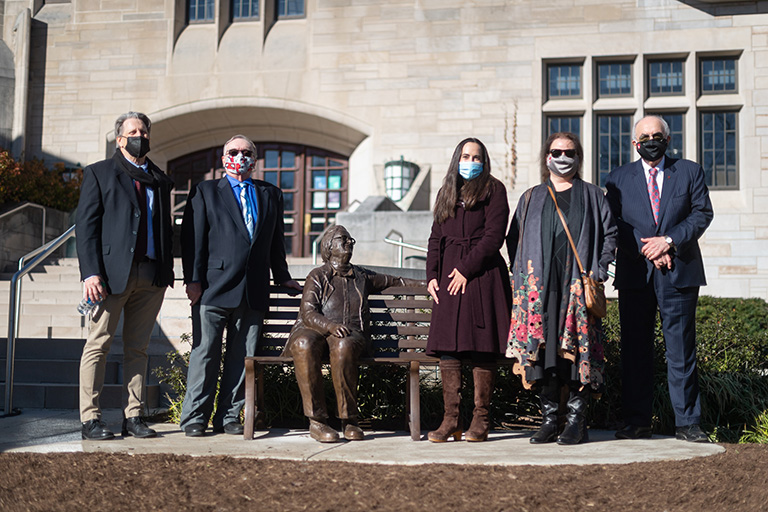Honoring the world-class accomplishments of a distinguished IU scholar
We gather at a time when universities around the nation and around the world—including our own—are engaged in introspection with a renewed focus on the individuals, past and present, whom we choose to honor in our public art and in the namings of our buildings and public spaces.
Like all great research universities, the essence of Indiana University is the gathering of outstanding scholars from across all disciplines and creative fields, which provides a rich environment for our faculty and students alike.
Thus, today we take great pride in celebrating the world-class accomplishments of a beloved former member of our faculty whose life and career brought enormous distinction to Indiana University—the late Distinguished Professor Elinor Ostrom, known affectionately to her colleagues and friends as "Lin."
Honoring Elinor Ostrom
Lin was, without question, a pioneer who was known around the world as a leading social scientist, and as a gifted, incisive, and truly creative scholar.
After earning her doctoral degree at UCLA—at a time when there was widespread resistance to admitting women to doctoral programs—Lin came to IU, and the university was incredibly fortunate to have had the benefit of her outstanding work as a teacher, researcher, advisor, and administrator for nearly half a century.
She was, of course, one of the primary forces behind the development of the academic study of the commons. But her work was also part of a much larger research project, which included examining the power of civil society, the development of social norms, and the voluntary collective action of citizens to solve problems.
Lin’s impressive body of work, together with the work of her late husband, Vincent Ostrom, formed a distinctive school of political-economic thought that is known around the world as "the Bloomington School." For nearly 50 years, the nexus of the Bloomington School has been IU’s renowned Ostrom Workshop, which Lin and Vincent established, and which we renamed their honor in 2012.
A series of notable "firsts"
Over the course of her distinguished career, Lin achieved many notable "firsts."
She was, of course, the first woman—and the first political scientist—to receive the Nobel Prize in Economics.
She was the first woman in the history of the IU faculty to be inducted into the National Academy of Sciences and the first woman on the IU faculty to be inducted into the American Academy of Arts and Sciences.
She was the first woman to receive the prestigious Johan Skytte Prize in Political Science and the first woman to receive the William H. Riker Prize in political science.
In October of last year, many of you were with us in this very location as we dedicated the first Bicentennial historical marker on the Bloomington campus in honor Lin.
And today, Lin achieves yet another "first" as we dedicate this Commons named in her honor and its splendid centerpiece sculpture—the first sculpture of a woman on the Bloomington campus.
As I mentioned earlier, the sculpture is part of the Bridging the Visibility Gap Project, an initiative of IU’s Office of the Bicentennial that has worked to recognize women and underrepresented minorities though historical markers, portraits and statues, named spaces, and named awards and positions.
Special Thanks
On behalf of Indiana University, I want to thank a number of people who helped make today’s celebration of Professor Ostrom—and the new sculpture and commons--possible.
I want to begin by commending sculptor Michael McAuley, from whom we will hear in a few moments, for the superb job he has done—as I am sure you will all agree when the sculpture is unveiled—in capturing Lin’s likeness, energy, and indomitable spirit.
I also want to express our most sincere thanks to the members of IU’s Well House Society, a giving society of the IU Foundation, whose members make annual gifts to IU. During the Bicentennial, we used Well House Society funds with a focus on campus beautification and honoring and preserving IU’s heritage, and gifts from Well House Society members made this splendid sculpture possible.
I also want to thank the members of the staff of the Office of the Bicentennial, including:
- Bicentennial Director Kelly Kish,
- Project Manager Jeremy Hackerd,
- Former Assistant Project Manager Angel Nathan
- Graduate assistant Ellie Kaverman and Former Bicentennial intern Claire Repsholdt, both of whom worked on the Bridging the Visibility Gap initiative.
"Rock-solid, theoretically informed, rigorous empirical and experimental research"
Political scientist Arun Agrawal, a frequent collaborator with Lin—of whom she spoke highly on numerous occasions—wrote in the German journal GAIA that “[Elinor Ostrom’s] scholarly contributions are founded upon the bedrock of evidence from literally tens of thousands of studies, refutable propositions based in fundamental social science, and rock-solid, theoretically informed, rigorous empirical and experimental research. It would be no exaggeration to say,” he continued, “that there is scarcely a political scientist better known within and outside the discipline.”[1]
And this was written several years before Lin received the Nobel Prize.
In the years and decades to come, the countless students, faculty, and visitors who pass through the Ostrom Commons will learn about Lin’s unfailing commitment to rigorous empirical and experimental research as they pause and reflect on the incredible impact of her life’s work on Indiana University and, indeed, the world.
Source Notes
1. Arun Agrawal, “12 Questions to Elinor Ostrom,” GAIA - Ecological Perspectives for Science and Society, Volume 15, Number 4, 2006, pp. 246-247.


